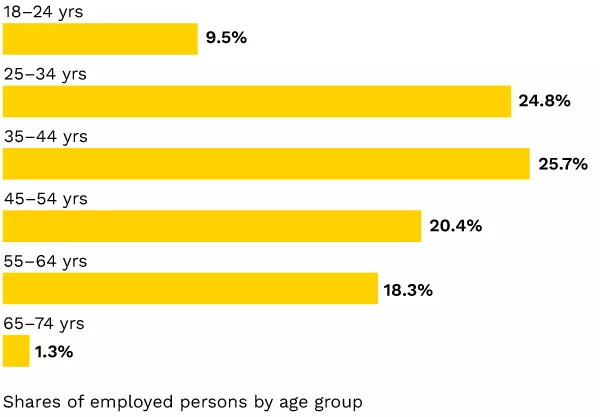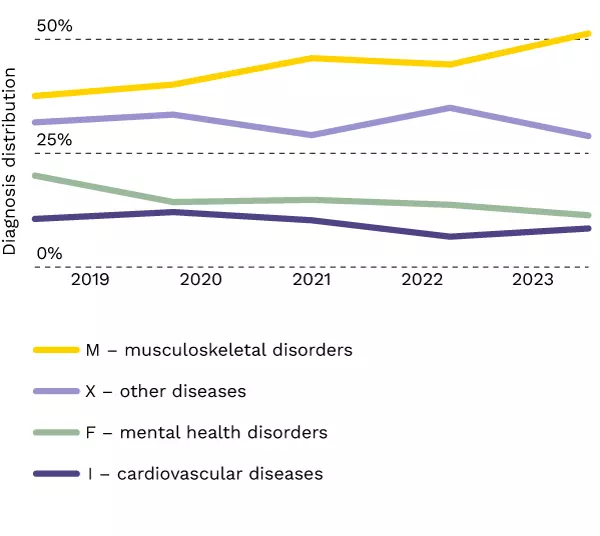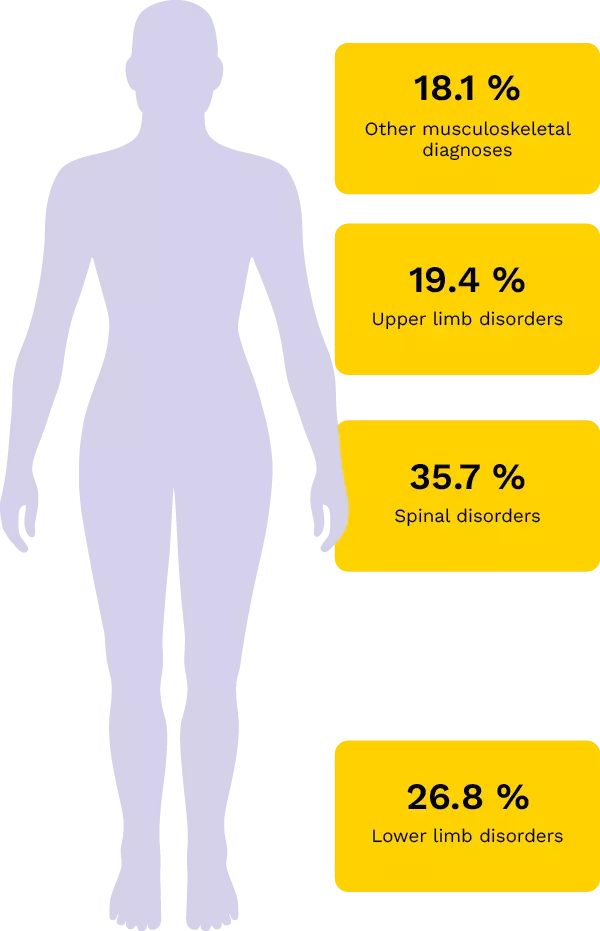Everyday working life in the construction sector
Construction sector jobs are primarily found in building construction, civil engineering and the construction product industry.
The sector covers a wide range of professions and work tasks. Employees in this sector work, for example, as painters, electricians, builders, HVAC installers or furniture fitters at worksites. White-collar workers and experts in the construction sector are working as architects, engineers and construction site managers.
Picture: The construction sector has employees of different ages.
Source: Statistics Finland, Employment statistics (2022)
The sector covers a wide range of professions and work tasks. Employees in this sector work, for example, as painters, electricians, builders, HVAC installers or furniture fitters at worksites. White-collar workers and experts in the construction sector are working as architects, engineers and construction site managers.
Picture: The construction sector has employees of different ages.
Source: Statistics Finland, Employment statistics (2022)

Work disability in the construction sector
Most of the disability pensions granted in the construction sector are related to musculoskeletal disorders. The share of disability pensions granted on the basis of mental health issues in relation to all disability pensions in the construction sector has remained at nearly the same level throughout 2020–2023.
Picture: Musculoskeletal disorders are a significant factor in terms of work disability in the construction sector.
Source: Elo's data (2019−2023)
Picture: Musculoskeletal disorders are a significant factor in terms of work disability in the construction sector.
Source: Elo's data (2019−2023)

Load factors and resources in the construction sector
Work-related stress and loading arise from the interaction between work and the employee. The relative strain experienced by the individual depends on both the load factors involved in the work and the employee’s own capabilities and resources. Harmful loading is preventable. A suitable amount of demanding work does, however, support an individual’s work ability. Many musculoskeletal disorders develop as a result of long-term work-related loading. Adopting healthy working habits that support work ability early on in one’s career will help to prevent the development and occurrence of musculoskeletal disorders later in one’s career.
Physical loading in the construction sector
The physical load of work may be related to specific movements and working positions or to the working environment and physical working conditions. In the construction sector, physical loading is caused in particular by:
- Difficult working positions such as kneeling or working with a bent back
- Working positions that twist the back
- Continuous overhead work that requires hands above shoulder level
- Extensive standing or walking during the workday and
- Lifting and moving heavy loads.
Picture: Back diseases are a common reason for disability pension in the construction sector. The musculoskeletal diagnoses are relatively evenly distributed to different parts of the body and subdiagnostic categories. Source: Elo's data (2019−2023)

Psychosocial work strain in the construction sector
Psychosocial workload factors are factors relating to the work arrangements, the content of work, the way in which work is organised and social dynamics at work. Psychosocial loading in the construction sector is particularly brought about by the hectic pace of timetables and the risk of accidents involved in dangerous work. According to studies, psychosocial risks such as a hectic pace and excessive time pressures also increase the risk of developing musculoskeletal disorders. Physical strain can lead to musculoskeletal pain, which can also affect the mental wellbeing of employees in the construction sector.
Key resources in the construction sector
In ideal situations, the construction sector has a lot of resources available to support the work ability of its personnel. Key resources in the construction sector include sufficient work recovery, opportunities for competence development, opportunities to influence one’s own work, support from one’s supervisor and work community, fair treatment and open communication.
Phenomena and trends in the construction sector
Competence within the construction sector
Changes in working life affect the construction sector and generate new skill requirements. The evolving need for different types of skills and knowledge requires employers to support the continuous learning of their employees at different stages of their working life and alongside their work. Insufficient work-related knowledge or occupational competencies can be a risk for work ability. Learning and competence management is a tool that work ability management utilises to strengthen work ability and the sustainable growth of the company. In terms of competence management, it is important to identify the specific characteristics of the sector within educational and training paths, the current competence needs of the company for different personnel groups, and the future competence needs caused by a changing operating environment. Personnel that are professionally competent and open to learning are more productive and boost the competitiveness of the company.Diversity among personnel
In construction sector companies, it is essential to take into account the employees’ individual needs for support and plan their tasks in a way that ensures that they can be carried out smoothly and that they offer diverse learning opportunities. The use of foreign labour is common in the construction sector, with the result that language skills, among other issues, may affect the onboarding process of employees and the formation of a functional work community. In addition, neurodiversity in the workplace brings its own components to learning, working approaches and interaction situations.
Digitalisation
Digitalisation and artificial intelligence are having a dramatic effect on working life, and the changes are also expected to impact work in the construction sector. According to the competence requirement survey, a large number of representatives of construction sector companies mention digitalisation as one of the most significant drivers of change affecting the sector evolution. Despite this, digital development is still only in the initial stages in many sector companies. New technologies create opportunities to enhance work efficiency, sustainability and green transition. The physical burdens of the work can also be reduced if heavy tasks can be handled by machinery. However, the introduction of digital tools requires orientation and proven experience that the new technologies are beneficial and support the work.
Solutions for work in the construction sector
The best result is achieved when development actions are targeted at several different levels:
- Workplace's operating models, processes and structures
- Leadership and management
- Physical work environment
- Psychosocial working conditions
- Social functionality of the work community
- Personnel's own capabilities
More solutions for supporting work ability
You will find more advice on supporting work ability in the everyday life of the construction sector in our information package.